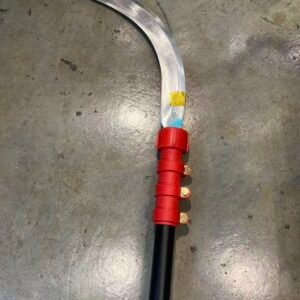Introduction
A beautiful and productive garden doesn’t happen by accident—it requires time, effort, and the right equipment. Whether U are a professional landscaper or a home gardening enthusiast, the right tools make every task easier and more enjoyable. In this guide, U will discover the 10 gardening tools every gardener should own for efficient planting, pruning, and soil care.
Having the proper gardening tools ensures not only better results but also saves U time and prevents strain or injuries. From digging to trimming, each tool plays a vital role in maintaining a healthy and flourishing garden.
1. Garden Spade
The garden spade is one of the most essential gardening tools. With its flat, sharp blade, it helps in digging, edging, cutting roots, and transferring soil. It’s perfect for shaping flower beds and preparing planting holes.
When choosing a spade, look for a strong carbon steel blade and a sturdy wooden or fiberglass handle for durability and comfort. Stainless steel blades are great if U prefer low maintenance and resistance to rust.
A well-designed spade can last years and is the foundation of most garden work.
2. Hand Trowel
A hand trowel is your best friend for smaller tasks. It’s ideal for transplanting seedlings, digging small holes, and removing weeds around delicate plants.
Choose one with an ergonomic handle to prevent wrist strain and a sturdy, rust-resistant blade. In professional gardens, trowels are used daily, making comfort and quality crucial.
Because of its versatility, no list of 10 gardening tools would be complete without it.
3. Garden Hoe
A garden hoe is perfect for weeding, cultivating soil, and shaping garden rows. It allows U to loosen compacted soil, helping plants grow healthier roots.
Traditional hoes, like the square hoe or stirrup hoe, are widely used depending on the type of soil and crops. For vegetable gardens, a lightweight hoe helps U weed quickly and efficiently without bending too much.
4. Pruning Shears (Secateurs)
Every gardener needs pruning shears for trimming branches, shaping shrubs, and removing dead leaves. Good shears ensure clean cuts that promote healthy regrowth.
Bypass pruners are ideal for living stems, while anvil pruners are better for dry or thick branches. Keep them sharp and clean to prevent plant disease.
These shears are essential in keeping your garden neat, especially during seasonal growth.
5. Watering Can or Hose
Proper watering is vital for every plant. A watering can is perfect for small gardens or indoor plants, while a hose with adjustable pressure is better for larger outdoor areas.
Modern garden hoses come with multiple spray settings that make watering easier and more efficient. Always check for leaks and use a fine nozzle for delicate plants like seedlings.
6. Rake
A garden rake is used to level soil, collect leaves, and prepare beds for planting. There are two main types: the leaf rake and the soil rake.
The leaf rake has flexible tines for sweeping debris, while the soil rake has rigid metal teeth that break up hard soil and smooth surfaces. For durability, choose steel heads over plastic ones.
7. Wheelbarrow
Moving soil, compost, or mulch can be hard work—unless U have a good wheelbarrow. It saves time and energy by allowing U to transport heavy loads easily.
Look for a sturdy steel tray and a pneumatic tire that can handle rough terrain. Whether U are working on landscaping or harvesting, this tool will make your work faster and more efficient.
8. Gardening Gloves
Gardening without gloves exposes your hands to thorns, blisters, and harmful chemicals. Quality gloves protect your skin and improve your grip while working.
Leather gloves are best for heavy-duty tasks, while cotton or rubber-coated gloves work well for light planting. Always choose gloves that fit snugly but allow your hands to move freely.
9. Garden Fork
A garden fork, also called a digging fork, is designed for loosening compacted soil and turning compost. Its strong metal tines can break up clay or rocky soil much easier than a spade.
Use it to aerate the ground, mix fertilizer, or move mulch. In professional farming or landscaping, the fork is an indispensable tool.
10. Garden Knife or Machete
For more rugged tasks—like cutting weeds, harvesting roots, or slicing through thick stems—a garden knife or machete is the ultimate choice.
Choose a high-carbon steel blade for sharpness and durability. Wooden or plastic handles provide comfort for long use. In tropical or agricultural areas, machetes are often used daily for both garden and farm work.
Bonus Tool: Gardening Hat and Boots
Though not always considered a “tool,” a hat and boots are essential for protection. A wide-brimmed hat shields U from the sun, and waterproof boots keep your feet safe and dry while working.
Maintenance Tips for Gardening Tools
To extend the life of your 10 gardening tools, always:
-
Clean them after each use.
-
Store them in a dry area to prevent rust.
-
Sharpen blades regularly for efficient cutting.
-
Oil moving parts like pruners and shears.
Proper maintenance ensures your tools stay reliable season after season.
How to Choose the Right Gardening Tools
When shopping for gardening tools, consider:
-
Material: Carbon steel or stainless steel for strength.
-
Handle: Wood for comfort, fiberglass for durability.
-
Weight: Lightweight tools for comfort, heavier for power tasks.
-
Purpose: Always match the tool to your garden’s size and type.
Good tools save U effort and give better results, especially for long working hours.
Conclusion
A successful garden depends on care, patience, and quality tools. With these 10 gardening tools, U can handle every planting, pruning, and soil management task efficiently.
From simple trowels to durable machetes, each item plays a unique role in making your garden healthy and beautiful. Invest in quality tools today, and let your garden reward U with abundant growth and lasting satisfaction.
View products




